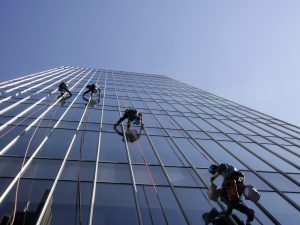Editor’s Note: The opinion expressed in this article does not necessarily reflect the opinions or policy of the Scaffold Industry Association.
It’s time to make some changes. Since 1996 we’ve been wrestling with fall protection for scaffold erectors without resolution. It’s time to make changes to the OSHA standards so we can provide maximum protection for the erector and still comply with the applicable standards.
First, here is a brief background on the erector fall protection issue. In November 1996, the U.S. Federal Occupational Safety and Health Administration, OSHA, introduced the revised scaffold standards for the construction industry. They are in 29 CFR 1926, Subpart L. These performance oriented standards replaced specification standards that had been in existence since the early 1970’s when the original OSHA standards were issued. Within the revised standards is a regulation that requires employers to “provide fall protection for employees erecting or dismantling supported scaffolds where the installation and use of such protection is feasible and does not create a greater hazard” (29 CFR 1926.451(g)(2)). Of great significance in this regulation is the requirement that “the employer shall have a competent person determine the feasibility and safety of providing fall protection for employees erecting or dismantling supported scaffolds.” In other words, the employer’s competent person is the sole authority for deciding whether the erector is to use personal fall protection. It is important to fully appreciate the significance of this requirement. In plain terms, if you are not the designated competent person (the person selected by the employer), you aren’t the one that will make the decision. This means that if you are a safety director for a general contractor you cannot override the decision. Equally so, if you are an OSHA compliance officer, you cannot override the decision. Besides the straight language of the standard itself, the scaffold enforcement directive, CPL 2-1.23, issued by the OSHA Directorate of Construction onJanuary 7, 1997, reinforces the clear language of the regulation by frankly stating “this decision is at the discretion of the competent person.”
Continuing in the regulations at 29 CFR 1926.451(g)(3), personal fall protection that is used shall, “In addition to meeting the requirements of 29 CFR 1926.502(d), personal fall arrest systems used on scaffolds shall be attached by lanyard to a vertical lifeline, horizontal lifeline, or scaffold structural member.” (Note: 29 CFR 1926.502(d) is in Subpart M (Fall Protection) of the standards, and specifies anchor strength, fall distances, and other pertinent requirements.) This poorly written regulation is interpreted in an infinite variety of ways, particularly if you read further and notice the statement “shall be independent of the scaffold.” What is a person to do! One regulation clearly states that the employer’s competent person is to determine feasibility of using personal fall protection while the next regulation seems to suggest which regulations must be met to determine feasibility. This brief background illustrates the problem.
Here is the solution. First, correct 29 CFR 1926.451(g)(3)(i). (Get your regulations out so you can follow along.) The first sentence needs a couple of words added. It should read (added words in italics): “When vertical lifelines are used on multi level suspended scaffolds,….” This will instantly clarify the intent of this sub-regulation and make more sense for everyone, particularly those who are not familiar with scaffolding. Second, waive the requirements of 29 CFR 1926.502(d) for scaffold erectors. As previously stated, the regulations found at 29 CFR 502(d) address anchor strength, fall distances and forces. My experience indicates that erectors are not following these regulations anyway, and OSHA is not enforcing them in any kind of systematic manner, so we have, in the past 8 years, been exempting erectors in a de facto sort of way. Actually, my experience shows that both regulations 2 and 3 have been misinterpreted and misapplied since November 1996, when they first appeared.
Let’s face it. Contrary to the standards and contrary to the enforcement directive, OSHA compliance officers and overzealous safety managers have assumed the burden of evaluating the competent person’s decision, not the competency of that person. This is in direct violation of the language of the standards, any reasonable interpretation of the standards, and in violation of OSHA’s own enforcement directive. Waiving the requirements of 29 CFR 502(d) will not increase the fall hazards for scaffold erectors and will accommodate both safety managers and compliance officers. Why should erectors have to use a 5,000 pound anchor when the force on their body can only be 1,800 pounds? Why should erectors have to use a 5,000 pound anchor when a properly used shock absorbing lanyard and fall protection system will only exert approximately 900 pounds on an anchor? Why is a 2 to 1 safety factor necessary for erectors when our only concern is that the erector not fall to his/her death? Finally, looking at it from another perspective, why should a scaffold erector hide behind a 5,000 pound anchor requirement to argue that he/she cannot properly tie off? Waiving the anchor requirements alone will make feasibility easier and more understandable.
There is precedent to waiving certain fall protection requirements. Masons are allowed to work on scaffolds without fall protection while laying up a wall. It is assumed that masons appreciate the concept that if they lean over too far, they’ll fall over the very wall they are constructing! Steel erectors are exempt from any fall protection at fall heights up to 15 feet. More amazing is that they are exempt, under certain conditions, from “tying off” between heights of 15 feet to 30 feet although they must wear their fall protection equipment. It can be argued, (although steel erectors won’t agree with me,) that it is easier for steel erectors to use personal fall protection equipment than scaffold erectors. After all, steel erectors have more substantial structural elements that can be used for anchors than scaffold erectors ever will. So, if we exempt masons and steel erectors, why not scaffold erectors?
Don’t get me wrong. It is my opinion that scaffold erectors must always use personal fall arrest systems whenever it is feasible and it is the employer’s competent person that must make the decision. Can we not give this competent person the tools and information to make a reasonable, responsible decision rather than a regulation that will only encourage further injuries and death? Let’s not leave artificial barriers for erectors to use as an excuse nor give compliance officers confusing regulations that can be subjected to tremendous abuse. It’s time to correct poorly written regulations and to waive the inappropriate fall protection requirements for scaffold erectors. The alternative is continued confusion, frustration, and death.












